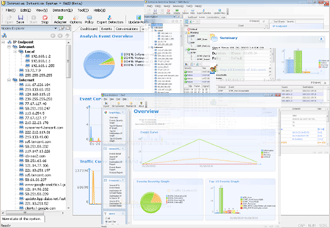Linux systems are widely used in servers of enterprises and organizations because of their open source, stability and high security. Network security issues are emerging one after another. How to protect Linux systems security from attacks is a vital task. In this context, the use of intrusion detection systems (IDS) has become one of the important measures to ensure the Linux systems security. Weak Password will introduce in detail how to configure and use intrusion detection systems in Linux systems.
1. Overview of Intrusion Detection Systems (IDS)
An Intrusion Detection System is a tool for monitoring network or system activities, primarily used to detect malicious behavior and violations of security policies. IDS generally falls into two categories:
1. Network Intrusion Detection System (NIDS): Monitors data flow across the entire network to identify suspicious network activities.
2. Host Intrusion Detection System (HIDS): Monitors activities on a single host, such as file and system call activities, focusing solely on the host’s security condition.
Common intrusion detection systems in the Linux environment include Snort, OSSEC, and AIDE.
2. Choosing an Intrusion Detection System
Different IDS have their characteristics and application scenarios. Therefore, consider the following aspects when selecting one:
1. System Resource Consumption: Choose a lightweight IDS to effectively reduce the impact on system performance.
2. Detection Capability: Ensure the tool can effectively recognize known attacks and abnormal behavior.
3. Usability: Opt for tools with good user documentation and community support to facilitate use and maintenance.
4. Scalability: Consider future system scalability and whether it supports plugins or custom rules.
3. Common Intrusion Detection Systems
3.1 Snort
Snort is a widely used network intrusion detection system capable of real-time detection and recording of suspicious activities in network traffic.
Features:
- – Supports analysis of multiple protocols.
- – Can be used for real-time traffic monitoring and storage.
- – Provides a robust rule engine, allowing users to customize rules.
3.2 OSSEC
OSSEC is an open-source host intrusion detection system that monitors file integrity, log analysis, and rootkit detection.
Features:
- – Supports multiple platforms (Windows, Linux, Mac).
- – Features centralized management, capable of monitoring multiple hosts.
- – Offers a web interface for configuration and monitoring.
3.3 AIDE
AIDE (Advanced Intrusion Detection Environment) is a file integrity checking tool capable of monitoring changes in files and directories.
Features:
- – Database-based file integrity checking.
- – Lightweight, suitable for low-resource environments.
- – Simple configuration, easy to use.
4. Configuring and Using IDS
Below is a detailed guide on how to configure and use an Intrusion Detection System in Linux, using Snort and OSSEC as examples.
4.1 Installing and Configuring Snort
4.1.1 Installing Snort
On Ubuntu, you can use the following commands to install Snort:
sudo apt update
sudo apt install snortDuring installation, the system will prompt you to configure the network interface to monitor.
4.1.2 Configuring Snort
For basic Snort configuration, edit its configuration file `/etc/snort/snort.conf`:
sudo nano /etc/snort/snort.confMake the following adjustments in the file:
– Network Interface: Specify the network interface to monitor, e.g., `HOME_NET`: `var HOME_NET 192.168.1.0/24`.
– Rule File: Ensure the required Snort rule files are enabled: `include $RULE_PATH/local.rules`.
– Log Settings: Configure the location and format for log output.
4.1.3 Running Snort
Run Snort to start monitoring the network:
sudo snort -d -e -i eth0 -c /etc/snort/snort.confThis command will start Snort, using the specified configuration file to monitor the assigned network interface.
4.2 Installing and Configuring OSSEC
4.2.1 Installing OSSEC
OSSEC installation is relatively straightforward; download the latest version package for installation. Here is an example for Ubuntu:
wget https://github.com/ossec/ossec-hids/archive/refs/tags/v3.3.0.tar.gz
tar -zxvf v3.3.0.tar.gz
cd ossec-hids-3.3.0
sudo ./install.sh
Follow the prompts during installation to configure and choose options suitable for your environment.
4.2.2 Configuring OSSEC
After installation, OSSEC’s configuration file is located at `/var/ossec/etc/ossec.conf`. Adjust monitoring behavior by editing this file:
sudo nano /var/ossec/etc/ossec.conf– Add Monitor Directories: Add paths to monitor within the “ tag.
– Configure Email Notification: Set email notification information in “.
4.2.3 Starting OSSEC
After completing the configuration, start the OSSEC service:
sudo systemctl start ossec
sudo systemctl enable ossec4.3 Log and Alert Management
Both Snort and OSSEC generate log files for subsequent analysis. Regularly check these logs to identify potential intrusion activities.
– Snort Logs: Typically saved in the `/var/log/snort/` directory, viewable using system commands like `tail` or `cat`.
– OSSEC Logs: Stored in `/var/ossec/logs/alerts.log`, where all detected alerts are recorded.
5. Best Practices
To enhance the Linux systems security, follow these best practices:
1. Regularly Update IDS Rules: Keep IDS rules updated to counter emerging threats.
2. Complex Configuration and Rule Management: Use version control tools like Git to manage IDS configuration files and rules, improving traceability and standardization.
3. Monitoring and Response Plan: Develop a comprehensive monitoring and response plan, clarifying the procedure for handling detected intrusions to allow for timely reactions.
- Log Analysis: Regularly perform log analysis to identify trends and anomalies for early detection of potential threats.
- Security Training: Provide security awareness training for personnel using IDS to enhance their ability to identify and respond to security incidents.
6. Conclusion
Intrusion Detection Systems are vital in ensuring Linux systems security by efficiently monitoring and addressing potential security threats. Proper configuration and use of IDS, combined with best practices, can greatly improve the Linux systems security . In the current environment of rising information security risks, bolstering the protection of networks and hosts is a critical responsibility. Achieving Linux system security depends not only on IDS but also on the development of a comprehensive security protection framework.


